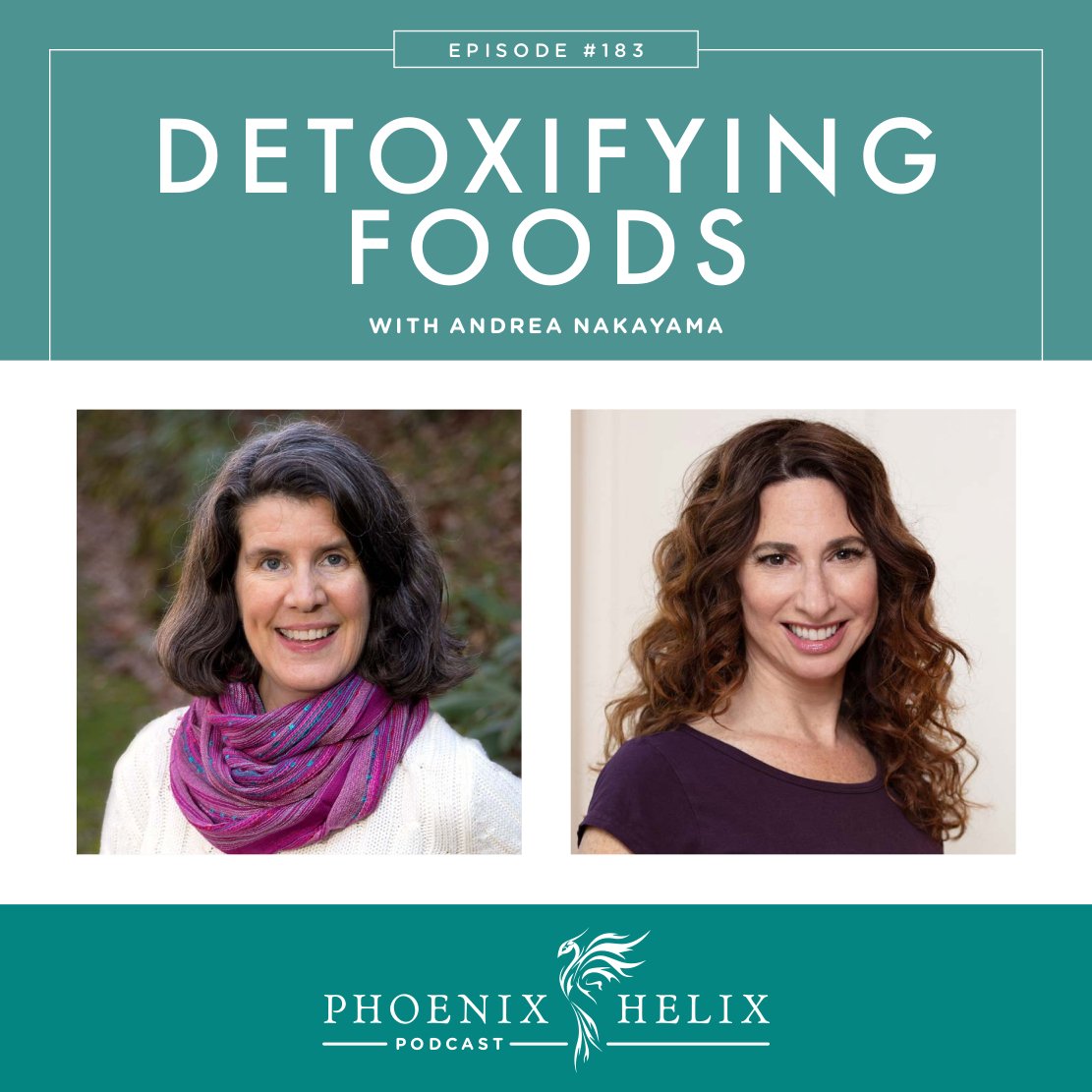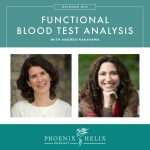
What Are the Best Foods to Support Detoxification?
Our bodies naturally have the ability to detoxify and do it every single day. However, problems can develop, and that’s not uncommon with autoimmune disease. The answer isn’t an aggressive “cleanse” where we try to force our bodies to do a year’s worth of detox in 30 days. Instead, we need to support our bodies year-round. There are foods that support our detox pathways, and foods that can interfere with them. That’s what today’s podcast is all about. My guest is Andrea Nakayama, a world-renowned functional nutritionist and educator, whose mission is to change the way we do healthcare by empowering patients to reclaim ownership over their own health.
Listen to the Show
- Subscribe to my podcast through your favorite podcast app: iTunes, Stitcher, Google, TuneIn, Spotify, Amazon, etc.
- You can also listen to the episode right here through the player below, and if you subscribe to my newsletter you’ll get notified of future episodes.
Podcast: Play in new window | Download
Show Notes
- Intro (0:00)
- Thank You To Our Podcast Sponsor – Araza Beauty (2:24)
- Our skin absorbs what we put on it, so it’s wise to read product labels, just as we read the labels on food. Sadly, makeup often contains some of the most toxic chemicals. Araza Beauty uses ingredients that actually nourish your skin. Their products are guaranteed to be free of synthetic ingredients, artificial colors, fragrances, gluten, and GMO’s. In fact, they’re the world’s first paleo certified makeup brand.
- While natural makeup often has a reputation for not working well, Araza is known for great pigmentation and blendability.
- Today, I’d like to highlight their bestselling, All In One Coconut Cream Foundation. It’s the ultimate skin protector by offering 25 SPF from non-nano zinc oxide. It also blocks artificial blue-light and protects against pollution. Lastly, it includes a post-biotic that balances your skin’s natural microbiome. It comes in 24 different skin tones, and they have a guide to help you find the right tone for you. They also sell sample sizes.
- This is just one of their products. They also sell eye shadow, lip color, cheek color, and more. Be sure to check out their whole product line.
- To learn more, visit ArazaBeauty.com/phoenixhelix, and use the code HELIX for 15% off your first order.
- Meet Andrea Nakayama (4:27)
- She has Hashimoto’s disease herself, which developed after a crisis in her family. Her husband was diagnosed with a brain tumor when she was pregnant, and he died 2-1/2 years later. The experience inspired her passion for health, both personally and professionally.
- She is now a world-renowned functional nutritionist, educator, and speaker. She’s trained thousands of practitioners through her Functional Nutrition Certification Program.
- Prior podcast interviews with Andrea:
- Ep. 27 – Hashimoto’s Disease.
- Ep. 70 – Functional Blood Test Analysis.
- Ep. 119 – Fatigue.
- Ep. 144 – Coronavirus and Autoimmune Disease (recorded at the start of the pandemic).
- An Overview of Detoxification (6:06)
- There are many checks and balances within our bodies, including the detox process, so remember that even if you have detox challenges, there’s still a lot going right. When we have chronic illness, it’s easy to forget that.
- Organs involved in detoxification: skin, intestines, kidneys, lungs, lymphatic system, and liver.
- 3 phases of liver detoxification:
- Phase 1 makes fat-soluble toxins water-soluble, so they’re easier to eliminate from the body. Otherwise, these toxins are stored in our fat cells and are often called obesogens. Our fat cells are actually protecting us from those toxins. After phase 1, the toxins temporarily become more toxic, producing more free radicals and creating more oxidative stress. That’s why the other phases are important – to neutralize and eliminate these toxins from our bodies. Genetic variations in the CYP450 enzyme system can sometimes create challenges with phase 1 liver detox.
- Phase 2 neutralizes the water-soluble toxins and makes them safe to eliminate. This is done through a number of different conjugation pathways: methylation, acetylation, sulfation, glucuronidation, amino acid conjugation, and glutathione conjugation. There are some genetic variations that may impact one of these pathways as well.
- Phase 3 eliminates toxins from our body through urine or stool. If we’re constipated or dehydrated, that contributes to toxic overload by preventing effective elimination from the body.
- All 3 phases need to be supported for effective detoxification. When you do a detox “cleanse” and feel worse instead of better, phase 2 isn’t keeping up with phase 1, or phase 3 is blocked.
- Functional Approach to Supporting Detoxification (12:32)
- Clear – Calm – Enhance – Modify. These are four ways we can support our health.
- For detoxification, we clear and calm by reducing our toxin exposure (including food toxins). We enhance and modify by supporting detoxification through nutrition and lifestyle choices.
- Andrea always recommends looking at the big picture before looking for a magic fix somewhere deep in the detoxification pathways. Macro interventions before micro. And when it comes to micro interventions, those are very personalized, because every body is different.
- Barriers to Detoxification (13:21)
- When it comes to toxins, environmental toxins matter, but food toxins do as well: processed foods (especially processed sugars and fats), chemicals in foods, and GMOs and pesticides.
- Inflammatory foods (our unique food sensitivities) increase inflammation and put a burden on our liver, so they become barriers to detoxification as well.
- When it comes to nutrition, there are certain nutrients essential to detoxification: B12, folate, and other B vitamins, as well as minerals like selenium and zinc. Deficiencies in these nutrients can inhibit proper detoxification.
- Smoke exposure can also be a barrier to detoxification.
- Certain pharmaceuticals may interfere with detoxification as well. However, if you are taking prescription medications to manage your autoimmune disease, those benefits are important. You might simply need to give yourself some extra detoxification support. (Resource: Where medication fits on a healing diet.)
- Mindset When Approaching Detoxification (16:29)
- When our bodies are highly symptomatic and we want to regain some control, we can fall into the trap of perfectionism. However, perfection is impossible, and that goal can add stress which becomes inflammatory and actually burdens our body and our liver. So, the goal is to improve our habits in a way that supports detoxification, without driving ourselves to obsession. Andrea likes the analogy of a road with poison ivy on one side, and a clear shoulder on the other. We want to avoid “poison ivy”, while also having room to veer occasionally onto the shoulder with no harm done. It’s about tuning into your body, to know what is non-negotiable (always needs to be avoided) and what’s more flexible.
- Resources:
- Article: Finding Your Wiggle Room on the AIP.
- Podcast: Ep. 161 – Perfectionism.
- Podcast: Ep. 134 – Orthorexia.
- Detoxifying Foods and Nutrients (21:05)
- Note: some of these foods aren’t part of the elimination phase of the AIP, but diets are meant to be personalized through the reintroduction process. Choose the foods that work well with your body.
- At a macro level, we need healthy fats, fiber, and sufficient protein to complete the detoxification steps.
- Zinc – is found in meat, shellfish, sweet potatoes, nuts, seeds, eggs, legumes, and grains.
- Selenium – is found in meat, fish, shellfish, eggs, and Brazil nuts.
- B vitamins – are found in meat, dark leafy greens, citrus, banana, avocado, nuts, seeds, eggs, legumes, and grains.
- Choline – is found in egg yolks, avocado, sunflower lecithin, and soy lecithin.
- Betaine – is found in beets.
- Vitamin C – is found in citrus (including zesting the peel), guava, kiwi, strawberries, papaya, broccoli, kale, bell peppers, and tomatoes.
- Cruciferous vegetables – arugula, bok choy, broccoli, Brussels sprouts, cabbage, cauliflower, collard greens, kale, kohlrabi, mustard greens, radishes, rutabaga, and turnips. When they’re fermented, their nutrients are even more bio-available.
- Antioxidants are needed to respond to the oxidative stress between phase 1 and 2 of liver detoxification (when the toxin has been liberated but not yet neutralized). Brightly colored foods contain antioxidants, so eat the rainbow.
- Thank You to Our Podcast Sponsor – ShopAIP (29:28)
- Today, I’m highlighting their canned and pouched seafood. Healthy fats support natural detoxification, and omega-3 fatty acids are anti-inflammatory as well. Canned seafood is an easy way to keep this nutrient-dense food on-hand for a quick meal or snack. ShopAIP sells wild-caught salmon, sardines, anchovies, mackerel, and low-mercury tuna.
- ShopAIP is an online store dedicated to the Paleo Autoimmune Protocol. With hundreds of items for the elimination phase of the AIP, and new products labeled by reintroduction category as well. You can find protein bars, sauces and condiments, AIP-friendly spices, cooking and baking ingredients, waffle and pancake mix, delicious snacks, and more.
- If you’re a first-time customer, use the code PHOENIX for 10% off your order. Purchase here.
- Troubleshooting Detoxification (30:51)
- Andrea always starts by looking at the big picture. A framework she uses to teach is called 3 Roots Many Branches. Detoxification is a branch. The roots are Genes, Digestion and Inflammation. So, when someone has a problem detoxifying, she looks to the roots first before trying to troubleshoot specific detox pathways. When the root causes are resolved, the branch issues often resolve on their own. If not, the body is better supported for targeted troubleshooting.
- For example, if someone has trouble digesting cruciferous vegetables, she’ll ask why? Is it the fiber that’s the problem? Or a specific compound like FODMAPs or sulfur? If yes, that shows digestion is a root cause. By addressing and improving gut health, the ability to digest those foods can often be restored. It’s not a fast process, and it’s unique to each individual, but it is possible. (Resource podcasts: Ep. 98 – Gut Health and Ep. 147 – Loss of Oral Tolerance.)
- In contrast, chelation or aggressive detox cleanses are trying to bypass root cause and force detoxification. This doesn’t address the underlying issues, and it can end up overwhelming the body.
- Another common mistake is putting too much emphasis on genes (mutations like MTHFR that may or may not impact detox capability). Andrea looks at genes through an epigenetic lens. Genes simply show possibilities. Not every mutation is actively expressed. Just because it shows up on your 23andMe test doesn’t mean it’s a problem.
- Is There a Healthy Way to Cleanse? (41:58)
- Andrea doesn’t recommend aggressive cleanses, but gentle, seasonal cleanses may be beneficial.
- Note: If you are already on a very restricted diet and working on rebuilding your health, now’s not the time to cleanse.
- Andrea’s recipe for a healthy cleanse:
- It should be short, rather than extended. A few days can be effective. For a healthier person, 1-2 weeks max. It’s not fasting. Nutrition is still important.
- Reduce your dietary fats (even the healthy ones), and reduce your animal protein. This gives the liver a “rest” so it can focus on deeper detoxification and regeneration.
- Increase your phytonutrients: vegetables and fruits.
- A liver-supportive herb like milk thistle is an optional addition, but avoid any herbs or substances designed to push toxins out of the cells.
- Another optional addition would be castor oil packs to support liver detoxification and colonics to support elimination. Epsom salt baths can also help gently support detoxification pathways without overloading them.
- What About Fasting? (45:32)
- Fasting is complicated. Sometimes it can be healing, but other times it can be triggering – physically or emotionally. Women especially often have a complex relationship with food and their body, and fasting can trigger body dysphoria or a stressful mindset. Fasting can also sometimes release toxins too quickly, becoming an aggressive cleanse rather than a gentle one. Andrea has incorporated a few days of juice fasting into her own cleanses, but if someone has blood sugar issues, that’s not recommended. So, fasting should be considered very carefully on a 1:1 basis.
- Resources:
- Detox Red Flags (49:08)
- One thing to remember is that our bodies are detoxing all the time. It’s part of our physiology, so cleanses aren’t necessary.
- If you choose to do one, it’s best to do cleanses with the support of a health professional, so you have someone to reach out to if symptoms become uncomfortable.
- Accelerated detox symptoms can be wide-ranging, but some common ones include fatigue, achiness, and skin symptoms.
- Increase your support of elimination pathways by drinking plenty of water and gently encouraging bowel movements (vitamin C and magnesium may be helpful). Epsom baths are also supportive. It’s also fine to stop the cleanse. Your body might be telling you it’s not beneficial for you right now.
- Detox Supplements (51:50)
- Potential indications that the liver is overburdened might include chronic headaches, dizziness, tenderness under the right ribcage, jaundice, extreme fatigue, lack of appetite, rashes on the back, and abnormal liver enzymes (shown on bloodwork ALT & AST). However, even when it’s clear the liver needs support, Andrea looks at the whole person to ask why the liver is overburdened and how the body can be supported overall. The liver is a downstream organ – if it’s struggling, it’s an indication there are imbalances elsewhere in the body. The liver is actually considered an auxiliary digestive organ, which is why digestive health is so essential to liver health.
- So, when considering supplements, Andrea looks at key nutrients that support overall health (including support for our detoxification pathways), rather than “detox supplements”.
- She’ll assess her clients’ diet to see where there might be nutrient deficiencies. The first step is trying to correct that through food before adding supplements, although supplements are sometimes beneficial. We mentioned these nutrients earlier in the podcast.
- Some supplements she may suggest (unique to each client) are magnesium, fish oil, B vitamins, and probiotics. Then later, after more foundational health support is in place, she may consider milk thistle or selenium as needed. She’s not a fan of multi-vitamins, because it’s too hard to tell what is and isn’t helping. She likes to introduce supplements in a more targeted way, where the impact on the body is more clear. A big part of our health journey is learning to tune in and listen to our bodies’ signals. The one exception is if someone has multiple deficiencies from a very nutrient-poor diet, she might consider a multi-vitamin as a bridge to bring those to sufficiency.
- Andrea’s Top 3 Lifestyle Tips to Support Detoxification (59:05)
- Special Detoxification Resources
- Andrea created a chart called 16 Tips to Champion Your Liver. You can print it off or save it to your computer for reminders.
- For more tips, check out my Detox Series here on my website.
- Outro (1:01:16)
- Andrea trains practitioners through The Functional Nutrition Certification Program. She also has a podcast for practitioners called the 15 Minute Matrix. You can listen to my prior interviews with Andrea here on the Phoenix Helix podcast: episodes 27, 70, 119, and 144.
- Eileen (your podcast host) is the author of multiple books, written to help people thrive with autoimmune disease. Learn more on the Books Page.
- If you like this podcast, follow or subscribe through your favorite podcast app. You can also subscribe to Eileen’s biweekly newsletter.
- Check out the entire archive of podcast episodes.
You May Also Be Interested In
Spreading the Word
If you like the podcast, please leave a positive review in iTunes. It would mean the world to me, and also helps others find the podcast. Here are some quick instructions using your iPhone:
- If you are already subscribed to my podcast: (1) Click the purple podcast icon. (2) At the bottom of the screen, click Library. (3) At the top of the screen, click Shows. (4) Click the Phoenix Helix podcast image. (5) Scroll down the page, and you’ll see Ratings and Reviews. Scroll down a little bit more and click on Write a Review. This will bring up the review screen. Tap 5 stars (if you love the podcast), and then click in the title box, and it will bring up the keyboard. Enter a title and short review. (6) Click Send in the upper right corner. (7) Thank you! Positive reviews give the podcast a higher search ranking in iTunes, helping people find it and letting them know it’s a quality podcast and worth their time to listen.
- If you haven’t subscribed to my podcast: (1) Click the purple podcast icon. (2) In the lower right corner, click the magnifying class. (3) Type Phoenix Helix in the search box. (4) Click the podcast cover in the Show list. (5) If you’d like to subscribe, click the + sign at the top of the screen. (6) To write a review, scroll down the page, and you’ll see Ratings and Reviews. Scroll down a little bit more and click on Write a Review. This will bring up the review screen. Tap 5 stars (if you love the podcast), and then click in the title box, and it will bring up the keyboard. Enter a title and short review. (7) Click Send in the upper right corner. (8) Thank you! Positive reviews give the podcast a higher search ranking in iTunes, helping people find it and letting them know it’s a quality podcast and worth their time to listen.







